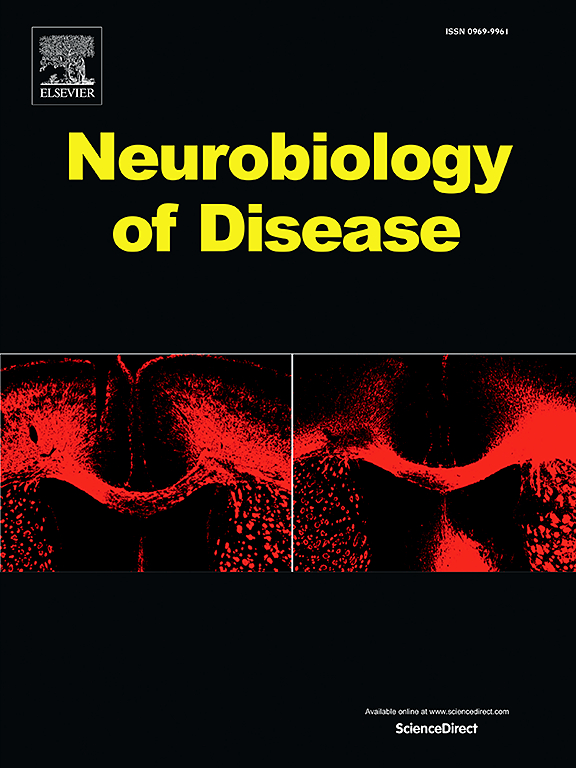Developmental and physiological impacts of pathogenic human huntingtin protein in the nervous system
IF 5.1
2区 医学
Q1 NEUROSCIENCES
引用次数: 0
Abstract
Huntington's Disease (HD) is a neurodegenerative disorder, part of the nine identified inherited polyglutamine (polyQ) diseases. Most commonly, HD pathophysiology manifests in middle-aged adults with symptoms including progressive loss of motor control, cognitive decline, and psychiatric disturbances. Associated with the pathophysiology of HD is the formation of insoluble fragments of the huntingtin protein (htt) that tend to aggregate in the nucleus and cytoplasm of neurons. To track both the intracellular progression of the aggregation phenotype as well as the physiological deficits associated with mutant htt, two constructs of human HTT were expressed in the Drosophila melanogaster nervous system with varying polyQ lengths, non-pathogenic-htt (NP-htt) and pathogenic-htt (P-htt), with an N-terminal RFP tag for in vivo visualization. P-htt aggregates accumulate in the ventral nerve cord cell bodies as early as 24 h post hatching and significant aggregates form in the segmental nerve branches at 48 h post hatching. Organelle trafficking up- and downstream of aggregates formed in motor neurons showed severe deficits in trafficking dynamics. To explore putative downstream deficits of htt aggregation, ultrastructural changes of presynaptic motor neurons and muscles were assessed, but no significant effects were observed. However, the force and kinetics of muscle contractions were severely affected in P-htt animals, reminiscent of human chorea. Reduced muscle force production translated to altered locomotory behavior. A novel HD aggregation model was established to track htt aggregation throughout adulthood in the wing, showing similar aggregation patterns with larvae. Expressing P-htt in the adult nervous system resulted in significantly reduced lifespan, which could be partially rescued by feeding flies the mTOR inhibitor rapamycin. These findings advance our understanding of htt aggregate progression as well the downstream physiological impacts on the nervous system and peripheral tissues.
致病人类亨廷蛋白对神经系统发育和生理的影响。
亨廷顿舞蹈症(Huntington's Disease,HD)是一种神经退行性疾病,属于九种已确定的遗传性多聚谷氨酰胺(polyQ)疾病之一。大多数情况下,HD 的病理生理学表现为中年人的症状,包括进行性运动控制能力丧失、认知能力下降和精神障碍。与 HD 病理生理学相关的是亨廷蛋白(htt)不溶性片段的形成,这些片段往往聚集在神经元的细胞核和细胞质中。为了追踪细胞内聚集表型的进展以及与突变体 htt 相关的生理缺陷,我们在黑腹果蝇神经系统中表达了两种具有不同 polyQ 长度的人类 HTT 构建物:非致病性-htt(NP-htt)和致病性-htt(P-htt),其 N 端 RFP 标记用于体内可视化。P-htt聚集体早在孵化后24小时就在腹侧神经索细胞体中聚集,孵化后48小时在节段神经分支中形成大量聚集体。运动神经元中形成的聚集体上下游的细胞器贩运显示出严重的贩运动力学缺陷。为了探索 htt 聚集可能造成的下游缺陷,对突触前运动神经元和肌肉的超微结构变化进行了评估,但未观察到显著影响。然而,P-htt 动物肌肉收缩的力量和动力学受到严重影响,这让人联想到人类的舞蹈症。肌肉收缩力的降低导致了运动行为的改变。我们建立了一个新的HD聚集模型,以追踪整个成年期翅膀中htt的聚集情况,该模型显示出与幼虫相似的聚集模式。在成体神经系统中表达P-htt会导致寿命显著缩短,而给苍蝇喂食mTOR抑制剂雷帕霉素可以部分缓解这种情况。这些发现加深了我们对htt聚集进展以及对神经系统和外周组织的下游生理影响的理解。
本文章由计算机程序翻译,如有差异,请以英文原文为准。
求助全文
约1分钟内获得全文
求助全文
来源期刊

Neurobiology of Disease
医学-神经科学
CiteScore
11.20
自引率
3.30%
发文量
270
审稿时长
76 days
期刊介绍:
Neurobiology of Disease is a major international journal at the interface between basic and clinical neuroscience. The journal provides a forum for the publication of top quality research papers on: molecular and cellular definitions of disease mechanisms, the neural systems and underpinning behavioral disorders, the genetics of inherited neurological and psychiatric diseases, nervous system aging, and findings relevant to the development of new therapies.
 求助内容:
求助内容: 应助结果提醒方式:
应助结果提醒方式:


